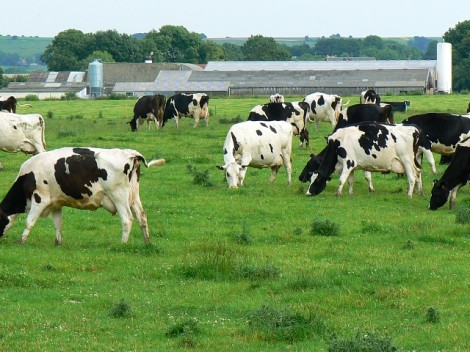TEACHING THE GEOGRAPHY OF FOOD
By Seth Dixon, Ph.D., Assistant Professor of Geography, Rhode Island College
Food. It’s something we all think about, talk about, and need. Food has been one major topic of interest at National Geographic because it connects all of us to our environment. The recent global population projections for the year 2100 just went up from9 billion to 11 billion, making the issues of food production and distribution all the more important. For the last 3 years I’ve stored podcasts, articles, videos, and other resources on my personal site on a wide range of geographic issues, including food resources. I thought that sharing 10 of my personal favorite resources on the geography of food would be helpful to understand our changing global food systems.
TOP TEN SUPPLEMENTAL RESOURCES TO THE GEOGRAPHY OF FOOD
TOP TEN SUPPLEMENTAL RESOURCES TO THE GEOGRAPHY OF FOOD
1. Ramen to the Rescue: Ramen is the most successful industrial food ever (100 billion serving yearly). This NPR article acts as a book review for The Noodle Narrativeswhich explores the global impacts of this massively important food source. In developed countries, most food experts bemoan ramen’s lack of nutritional value and see it as a symptom/cause of larger issues of unhealthy diets and obesity. At the global scale however, some anthropologists are seeing ramen as the ‘proletariat hunger killer’ as it becomes a staple of the undernourished in megacities and less developed countries, and the poor in the developed world.
Too often, educators hear student respond that food comes from the grocery store. With more thought, the farm would be the next answer, but what kind of farm? Which farm? Where is it coming from? All you need to arm your students to make the commodity chain more personal is the code on the carton and this link, and they are on their way to exploring the geography of industrial agriculture (more likely than not). This site is designed to help consumer become more aware of the geography of diary production and to get to know where the products that we are putting in are body are coming from. My milk (consumed in Rhode Island) is from Guida’s Milk and Ice Cream from New Britain, CT. So, where does your milk come from?
No one should be surprised that more developed societies are more wasteful societies. It is not just personal wasting of food at the house and restaurants that are the problem.National Geographic Explorer Tristam Stuart shows that perfectly edible food is thrown out due to size (smaller than standards but perfectly normal), cosmetics (Bananas that are shaped ‘funny’) and costumer preference (discarded bread crust). This is an intriguing perspective on our consumptive culture, but it also is helpful in framing issues such as sustainability and human and environmental interactions in a technologically advanced society that are often removed form the land where the food they eat originates.
4. Chipotle’s Commercials:
These videos are extremely risky business. These videos perfectly encapsulate the beliefs, values and ethics that underscore the organic farming movement and resonate with consumers. This is a key part of Chipotle’s advertising campaign, food with integrity. Many within the agricultural industry are not amused, and as a group they are Chipotle’s suppliers. “In general, this romanticized view of agriculture is not going to be able to feed the world,” said Tom Super who is the spokesman for the National Chicken Council. Many in the industry think that Chipotle pushing its values on consumers. See this article for more on the tension between Chipotle and agricultural suppliers.
5. Does Big Farming Mean Bad Farming? : In the long run, a successful farmer needs to find a balance between economic and environmental sustainability. Some big farms are working towards that so the ‘big-equals-bad’ narrative about agriculture may be easy, but it doesn’t tell the whole story about modern agriculture as this Washington Post article explains.
6. TED Talks on Global Hunger:
Many advocates of local foods favor a small-scale approach to farming and are opposed to large-scale agribusiness. It might be easy for those disconnected from the food production system (like me) to romanticize and mythologize the farmers of yesteryear and yearn to return to this past. The first talk highlights how essential large-scale farming is absolutely critical to feeding the global population; the second TED talk discusses many of the hunger problems especially the uneven access to food. Here are some other pro-agribusiness resources.
7. Rethinking Urban Agriculture:
There has been a revitalization in urban gardening as many city dwellers feel disconnected from their food systems; urban gardening is a way for people to actively control what they are ingesting into their systems many fear some of the modern agricultural methods. Based in Milwaukee, WI, Growing Power has created an interesting combination of vegetable gardening and aquaponics for the urban environment.
9. The Changing Geography of Quinoa: Quinoa was once a traditional Andean grain that few outside of South America consumed, but it has quickly become a staple among the health-conscious in developed countries in recent years. Dieticians and nutritional experts give it their seal of approval because it is a low-fat starch that is high in protein and filled with amino acids. This rapid adoption of quinoa in high-priced whole food stores has changed the economics of quinoa dramatically. Peruvian and Bolivian farmers are selling at high prices with huge global demand. Local consumers who have traditionally relied on this crop however, now have to pay triple the price to eat quinoa, causing some to question the ethics of quinoa consumption. A simple change in cultural eating habits in one part of the world can have some major impacts on the economy and agriculture of another region.
 The story of the Red Delicious is almost a perfect analogy for the food industry. It was genetically selected for its marketable skin, an aesthetically sumptuous red. The skin of the Red Delicious better covers bruises than other varieties and tastes more bitter. Consumers were buying what the industry promoted and “eating with their eyes and not their mouths.” But recently there has been a backlash in the United States and more American consumer are seeking out other varieties; meanwhile the apple producers are working on exporting this variety to around the world, but especially into Chinese markets.
The story of the Red Delicious is almost a perfect analogy for the food industry. It was genetically selected for its marketable skin, an aesthetically sumptuous red. The skin of the Red Delicious better covers bruises than other varieties and tastes more bitter. Consumers were buying what the industry promoted and “eating with their eyes and not their mouths.” But recently there has been a backlash in the United States and more American consumer are seeking out other varieties; meanwhile the apple producers are working on exporting this variety to around the world, but especially into Chinese markets.
These 10 are a select few of my very favorite resources on the Geography of Food (many more can be found here). What are your favorite resources to teach students about the complex food production and food distribution systems that feeds everyone on Earth?


No comments:
Post a Comment